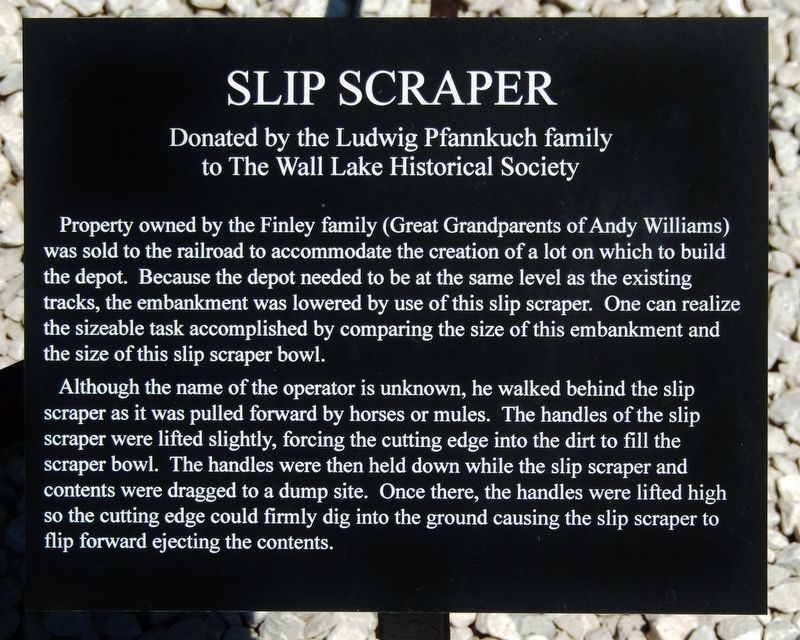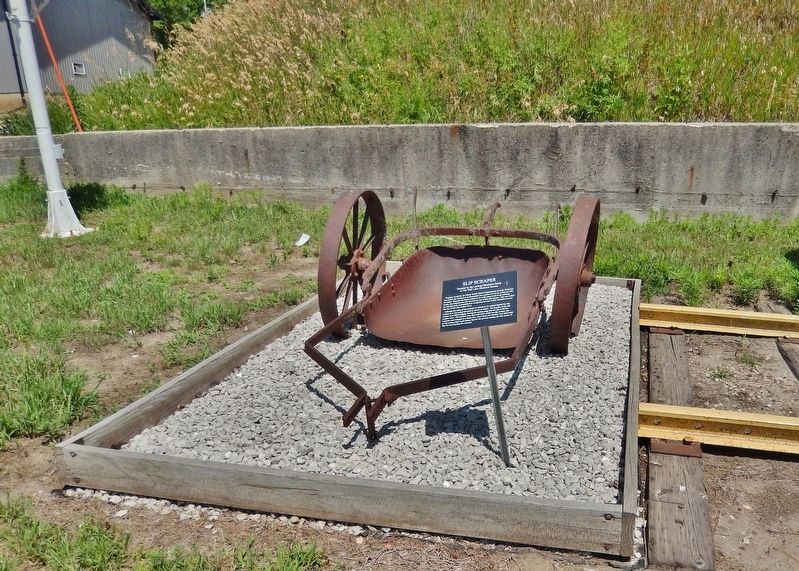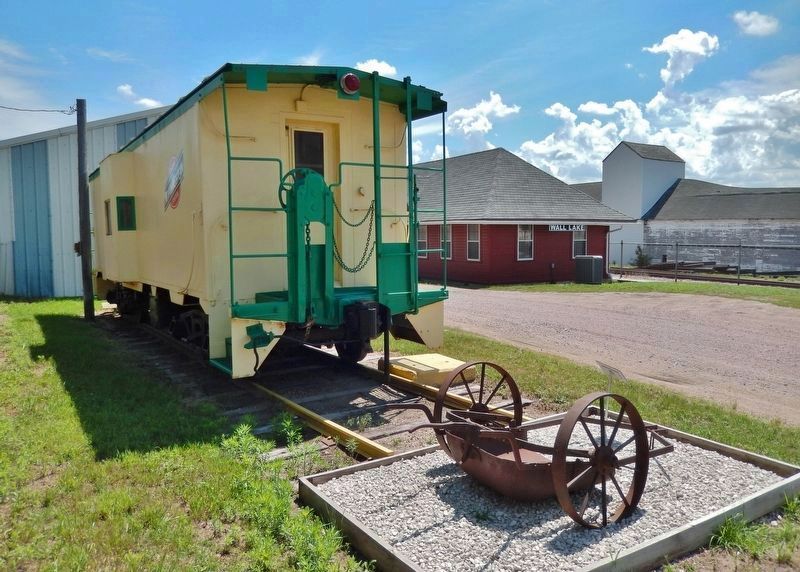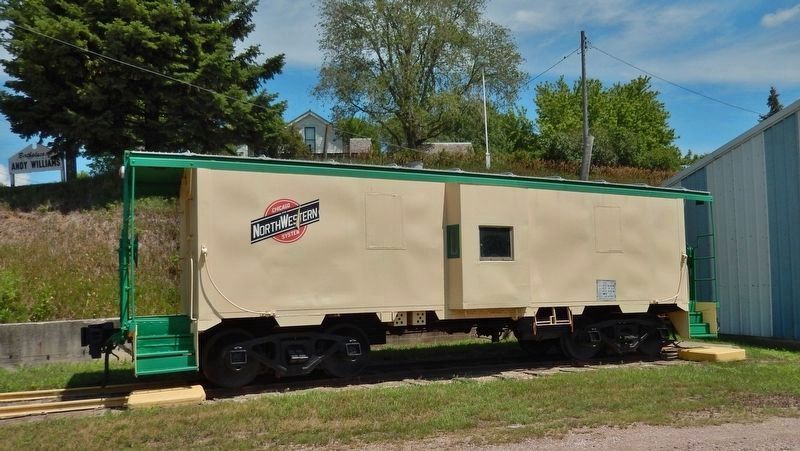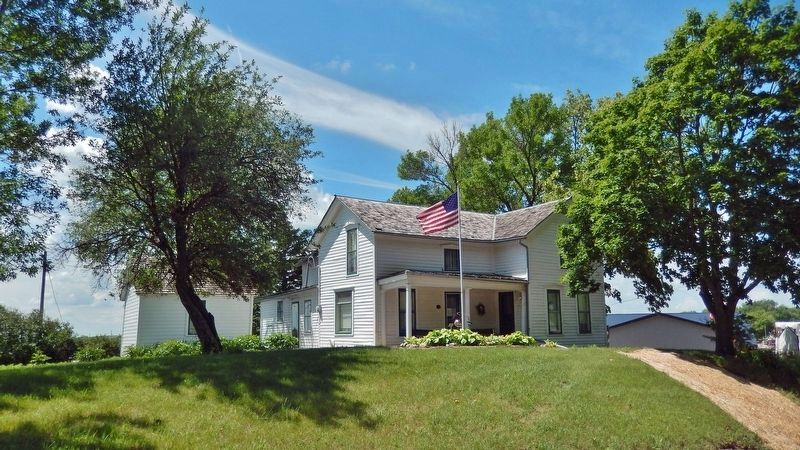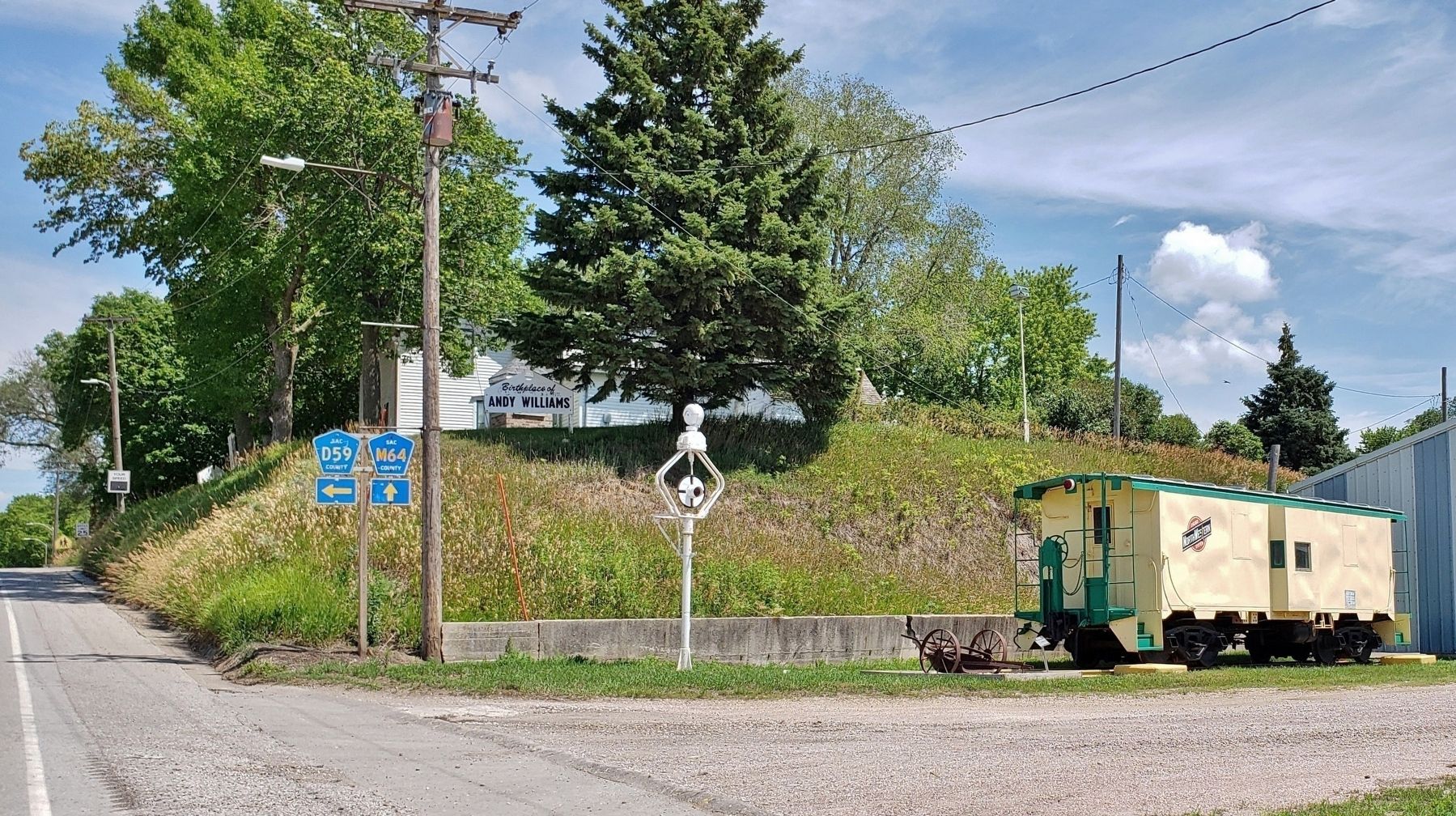Wall Lake in Sac County, Iowa — The American Midwest (Upper Plains)
Slip Scraper
to The Wall Lake Historical Society
Property owned by the Finley family (Great Grandparents of Andy Williams) was sold to the railroad to accommodate the creation of a lot on which to build the depot. Because the depot needed to be at the same level as the existing tracks, the embankment was lowered by use of this slip scraper. One can realize the sizeable task accomplished by comparing the size of this embankment and the size of this slip scraper bowl.
Although the name of the operator is unknown, he walked behind the slip scraper as it was pulled forward by horses or mules. The handles of the slip scraper were lifted slightly, forcing the cutting edge into the dirt to fill the scraper bowl. The handles were then held down while the slip scraper and contents were dragged to a dump site. Once there, the handles were lifted high so the cutting edge could firmly dig into the ground causing the slip scraper to flip forward ejecting the contents.
Topics and series. This historical marker is listed in these topic lists: Entertainment • Railroads & Streetcars. In addition, it is included in the National Register of Historic Places series list. A significant historical year for this entry is 1899.
Location. 42° 16.222′ N, 95° 5.426′ W. Marker is in Wall Lake, Iowa, in Sac County. Marker is on Center Street (County Road D59) just south of 1st West Street, on the left when traveling south. The marker and slip scraper exhibit are located near the former Chicago & North Western Passenger Depot. Touch for map. Marker is at or near this postal address: 102 1st West Street, Wall Lake IA 51466, United States of America. Touch for directions.
Other nearby markers. At least 8 other markers are within 14 miles of this marker, measured as the crow flies. Odebolt • Popcorn Capital of the World (approx. 8½ miles away); Odebolt World War I Monument (approx. 8.7 miles away); Odebolt Centennial Time Capsule (approx. 8.7 miles away); Iowa Rural Schools History (approx. 8.7 miles away); Sac City Freedom Rock Veterans Memorial (approx. 11.7 miles away); Lest We Forget (approx. 13 miles away); World's War Soldiers (approx. 13 miles away); Westside (approx. 13½ miles away).
Also see . . .
1. Slip Scoop [Slip Scraper] & Horse-Drawn Bobcat (including photos). Excerpts:
(by Steve Cornelius of Columbia City, IN.) A slip scoop is a very useful tool around the farm. This country was built with them. Roads, big excavations for buildings etc. were dug with them. To dig with a slip scoop the dirt must be fairly loose. If it isn’t they used a hook shaped ripper to loosen it first. Your lines must be around your back under one arm only, not around your waist, because if that scoop trips unexpectedly (and it will) you want to be able to get out of its way. Ideally your lines should be just long enough that when starting out between handles you can stop horses by leaning back and to control speed. You don’t want to be leaning too far forward, it’s like a walking plow, you must be comfortable, it’s hard enough work without making it harder. You need a team for most slip scoop work but a single horse can handle it if you’re just hauling manure.(Submitted on January 21, 2024, by Cosmos Mariner of Cape Canaveral, Florida.)
2. Chicago and North Western Passenger Depot (Wikipedia). Excerpts:
The C&NW depot is an example of a combination station plan. The plan combined both passenger and freight services in one building. They were commonly used during the heyday of railroad growth around the turn of the 20th century. The depot was built in 1899 by A.H. Carter & Co. of Cedar Rapids, Iowa as a replacement depot. The single-story frame structure is the only building used as a depot that remains in town. It was listed on the National Register of Historic Places in 2003.(Submitted on January 21, 2024, by Cosmos Mariner of Cape Canaveral, Florida.)
3. Birthplace of Andy Williams (RoadsideAmerica.com).
Excerpt:
Andy Williams was born in this house in 1928. The house languished in obscurity until 1992, when it was purchased by the local historical society and slowly restored to an approximation of the way that Andy would have remembered it as a kid. (The Williams family moved to Des Moines when Andy was six.) It's furnished with items "typical of that era," but not specific to Andy.(Submitted on January 21, 2024, by Cosmos Mariner of Cape Canaveral, Florida.)
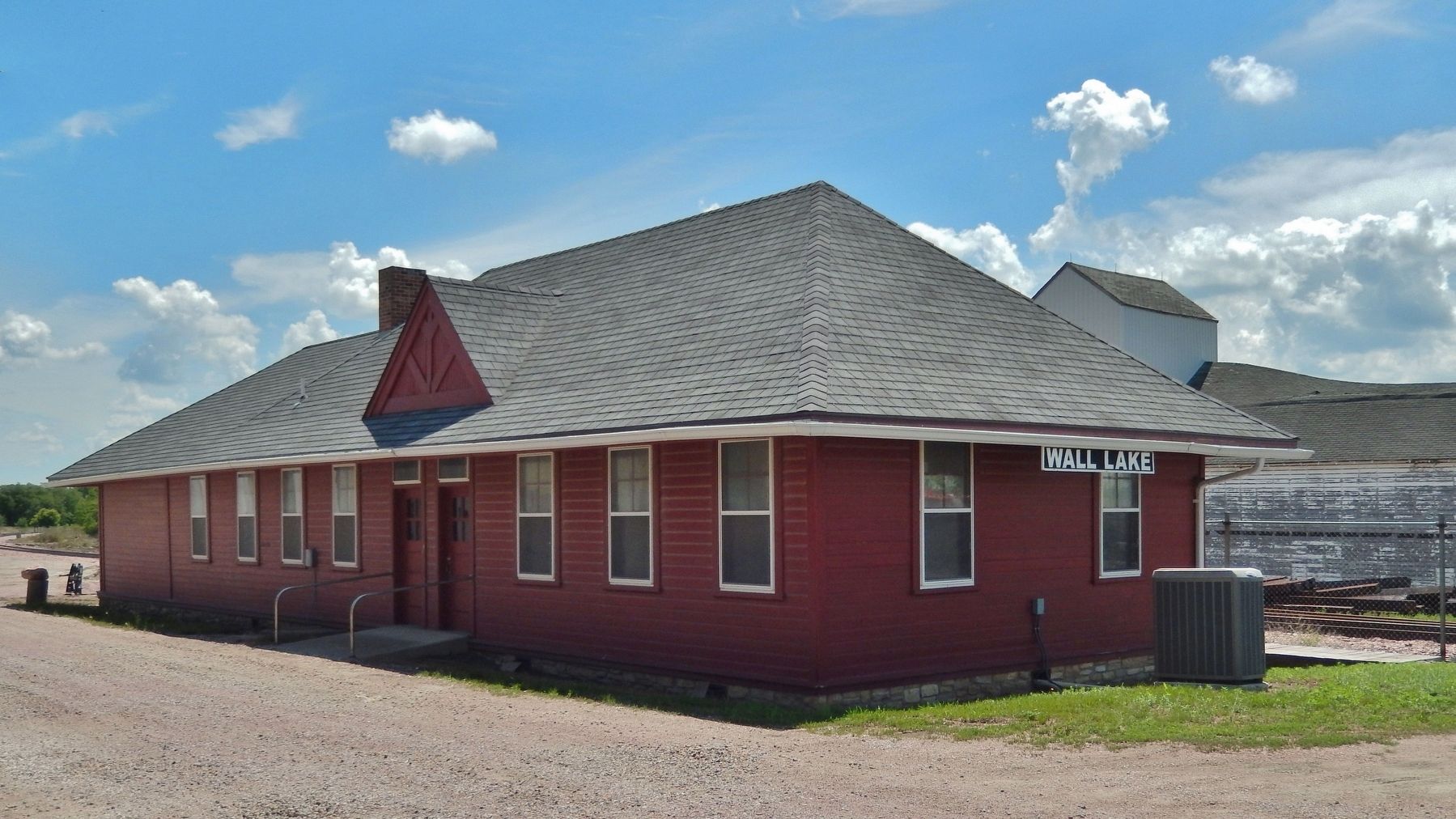
Photographed By Cosmos Mariner, June 30, 2021
6. Chicago & North Western Passenger Depot — National Register of Historic Places #03000358
From the National Register Nomination: The Chicago & North Western Passenger Depot at Wall Lake, Iowa is a one-story wood frame building measuring 24 x 81 feet. Constructed in 1899 as a replacement depot, it is sited on an east-west axis with the front façade oriented toward the track on the south side. As built, a 12 x 300-foot plank platform ran along the front facade and connected to 24 x 20 baggage and express building, separated from the depot by a breezeway.
The depot is the only surviving structure in Wall Lake to provide evidence of the enormous role that rail transportation played in the life of this small town from the 1880s until about World War II. By the turn of the century, Wall Lake, with a population of not quite 800, was served by both the Chicago & North Western and the Illinois Central railroads. Access to agricultural products; to extensive sand and gravel deposits northeast of Wall Lake; and to nearby hunting, fishing, and water recreation areas provided the impetus for railroad competition in the area.
Although not as substantial as many second-generation depots, which often were constructed of brick, the Wall Lake depot nonetheless reflects the railroad line's concern with public image during an era of growth and competition for passengers and freight. By 1899, when the depot was constructed, the Chicago & North Western had absorbed a variety of lines and aimed to simplify its corporate structure as well as minimize operating costs. The company thus adopted three standard combination depot plans, the design of which has been attributed to the prominent Chicago architectural firm of Frost and Granger. The three plans varied according to size and use of interior space, with Number One being the largest and most elaborate of the three inasmuch as this is the only plan to incorporate a separate waiting room for women. By 1902, the C&NW reportedly had built about two dozen "Number One" depots in Iowa, Wisconsin, Minnesota, and South Dakota. How many Number One standard-plan depots are extant in these four states is currently undetermined, but the number cannot be large because so many railroad structures have been demolished.
The depot is the only surviving structure in Wall Lake to provide evidence of the enormous role that rail transportation played in the life of this small town from the 1880s until about World War II. By the turn of the century, Wall Lake, with a population of not quite 800, was served by both the Chicago & North Western and the Illinois Central railroads. Access to agricultural products; to extensive sand and gravel deposits northeast of Wall Lake; and to nearby hunting, fishing, and water recreation areas provided the impetus for railroad competition in the area.
Although not as substantial as many second-generation depots, which often were constructed of brick, the Wall Lake depot nonetheless reflects the railroad line's concern with public image during an era of growth and competition for passengers and freight. By 1899, when the depot was constructed, the Chicago & North Western had absorbed a variety of lines and aimed to simplify its corporate structure as well as minimize operating costs. The company thus adopted three standard combination depot plans, the design of which has been attributed to the prominent Chicago architectural firm of Frost and Granger. The three plans varied according to size and use of interior space, with Number One being the largest and most elaborate of the three inasmuch as this is the only plan to incorporate a separate waiting room for women. By 1902, the C&NW reportedly had built about two dozen "Number One" depots in Iowa, Wisconsin, Minnesota, and South Dakota. How many Number One standard-plan depots are extant in these four states is currently undetermined, but the number cannot be large because so many railroad structures have been demolished.
Credits. This page was last revised on January 21, 2024. It was originally submitted on January 20, 2024, by Cosmos Mariner of Cape Canaveral, Florida. This page has been viewed 61 times since then. Photos: 1, 2, 3, 4, 5, 6, 7. submitted on January 21, 2024, by Cosmos Mariner of Cape Canaveral, Florida.
